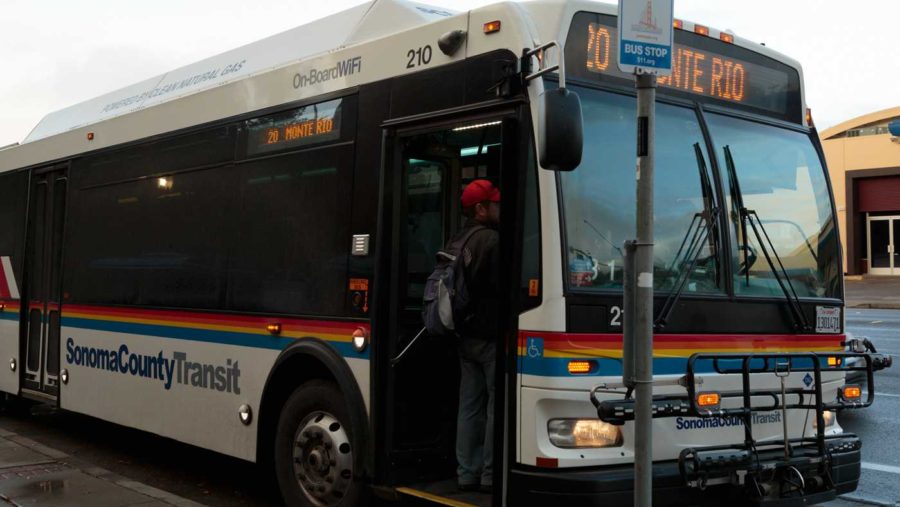Veterans and college students can ride on Sonoma County Transit for free starting Jan. 1, 2015. The Sonoma County Board of Supervisors unanimously approved the Subsidized Fare Pilot Program at the Sept. 30 meeting.
“With having two different campuses, a lot of students end up having to go to both and this will really help,” said SRJC student Cody Buka, 25, of Rohnert Park.
In July, the board directed Transportation and Public Works (TPW) and the County Administrator Office (CAO) to develop a reduced-cost transit pass pilot program for college students who use Sonoma County Transit. The program broadened to include veterans when John Logan, part of Chapter 78 of the Military Order of the Purple Heart Foundation in Santa Rosa, brought the issue to Sonoma County Supervisor Mike McGuire.
“Veterans are our county’s most vulnerable population,” McGuire said.
The board asked Logan and his colleagues to gather information about the number of veterans who visit the Santa Rosa Veterans Outpatient (VA) Clinic, and they calculated about 600 veteran rides per month.
“Our ultimate goal is to get as many barriers and obstacles out of the way so that [veterans] can get where they need to go so that they can get back on their feet and make the next steps easier to find a future,” Logan said.
Ending Dec. 31, 2015, the yearlong trial program is intended to increase ridership and allow easier access to facilities like Santa Rosa Junior College, Sonoma State University, Santa Rosa Clinic and future SMART stations. The program will determine the true cost of offering free bus fares, according to a Sonoma C o u n t y Supervisors report.
W h e n boarding a Transit bus, the student or veteran has to flash a valid identification card and the bus driver will keep track of that data on a daily basis. The data will then be compiled and presented to the Board of Supervisors for evaluation in the middle of 2015, and again at the end of the year.
Because college students have seen significant increases in fees and housing costs since the recession, the program strives to put an additional $500 back into the students’ pockets, McGuire said.
The program includes Empire College and the University of San Francisco’s Santa Rosa branch, as well as other institutions that meet the requirements.
The program will cost the County general fund $311,000, and will be paid to Sonoma County Transit. Half of the payment is for the current fiscal year ending in 2015, and the remaining half for the 2015- 2016 fiscal year.
The board anticipated a 25 percent increase in ridership, and adjusted the costs to not exceed the budget. Any leftover money will remain in the general fund.
“As we all know, students struggle every month to survive financially, so now students won’t have to pay for passes,” McGuire said. “We hope it will be an economic benefit and students can invest in their education.”
The projected cost is an estimated $266,000 from students and $45,000 from veterans based on Sonoma County Transit’s current cash fares from college students.
SRJC student Frank Maleque, 22, was nonchalant about the idea of free transportation. “It’s OK,” he said. “I have the Super Pass, but I’ll probably take advantage of that.”
“I think it sounds like a great idea,” said Austin Cetrangolo, 19, who rides from Sonoma to SRJC, after hearing about the program for the first time. “It will definitely save me money,” he said.
On the other hand, Naomi Murphy, 18, was unsure about the program. “I have mixed emotions about it. I guess it affects me, but I know it could also affect the city,” she said. She feels that the money for the program could possibly go to something else, as she isn’t bothered by the $1.60 she pays to ride the bus from Rohnert Park to SRJC.
“Our goal is to make sure every college student knows they can ride for free,” McGuire said. “We want as many students as possible to take advantage of the free rides.”



Pryce Grier • Jan 26, 2016 at 11:52 pm
Students who live in Marin and take the bus from there should also be getting this benefit. The bus fare from Marin to Sonoma affects the SRJC students in Marin financially more than those in Sonoma. I believe SRJC students who live in Marin deserve this benefit just as much if not more than the students in Sonoma.
JS • Jan 3, 2015 at 8:50 am
It would have been interesting if this decision was more open to public debate. For example, is this the best and most fair use of $300k, even if they’re allocating it specifically to transportation?
Like Naomi, sometimes I ride from Rohnert Park to Santa Rosa, and they actually cut a regularly full weekday 44 bus from the last schedule. So the plan is to increase ridership but cut busy routes?